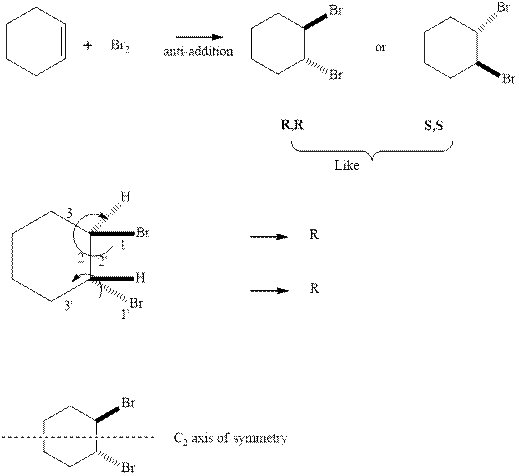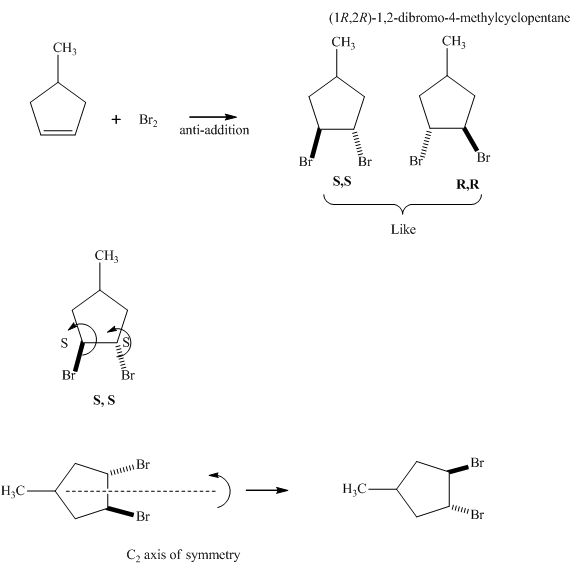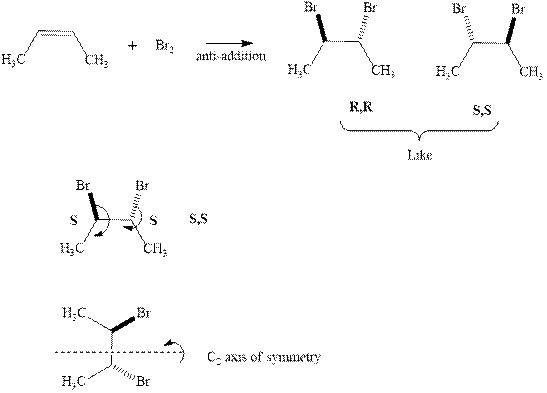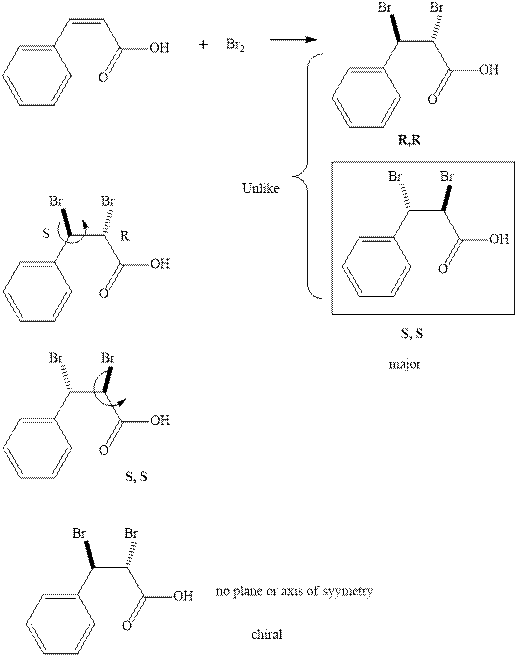
Concept explainers
(a)
Interpretation:Whether the major product formed will have like or unlike stereochemistry or whether it is chiral or meso should be determined.

Concept introduction:In order to assign absolute configuration of R and S, Cahn − Ingold − Prelog rules are used and the first step is to assign the priority order with the
In order to distinguish the relative stereochemistry of two chiral centers situated adjacent to one another, like or unlike notation is used.
For enantiomeric pairs that have same stereochemistry at adjacent carbon atoms, the notation “l” designates “like” and notation “u” designates“un-like”.
Four kinds of symmetry elements that may be present are tabulated as follows:
Presence of any symmetry element makes molecule achiral and optically inactive.
(a)
Explanation of Solution
If the groups now are arranged are read from highest towards least in clockwise fashion then R is assigned to the stereocenter, if the rotation is anticlockwise then S is assigned at the configuration.
The products formed in reaction with bromine are both R due to the clockwise priority order indicated in the reaction below.

Since the enantiomers have same stereochemistry on both the carbons so they are like. These enantiomers have
(b)
Interpretation:Whether the major product formed will have like or unlike stereochemistry or whether it is chiral or meso should be determined.

Concept introduction:In order to assign absolute configuration of R and S, Cahn − Ingold − Prelog rules are used and the first step is to assign the priority order with the atomic number as the fundamental property. The one with the highest atomic number gest highest priority and is designated as “1” and so on.
In order to distinguish the relative stereochemistry of two chiral centers situated adjacent to one another, like or unlike notation is used.
For enantiomeric pairs that have same stereochemistry at adjacent carbon atoms, the notation “l” designates “like” and notation “u” designates “un-like”.
Four kinds of symmetry elements that may be present are tabulated as follows:
Presence of any symmetry element makes molecule achiral and optically inactive.
(b)
Explanation of Solution
If the groups now are arranged are read from highest towards least in clockwise fashion the R is assigned to the stereocenter, if the rotation is anticlockwise the S is assigned at the configuration.
The products formed in the reaction of bromine are R and S indicated in the reaction below.

Since the enantiomers have different stereochemistry on both the carbons so they are unlike. These enantiomers have no plane or axis of symmetry so they are chiral.
(c)
Interpretation:Whether the major product formed will have like or unlike stereochemistry or whether it is chiral or meso should be determined.

Concept introduction:In order to assign absolute configuration of R and S, Cahn − Ingold − Prelog rules are used and the first step is to assign the priority order with the atomic number as the fundamental property. The one with the highest atomic number gest highest priority and is designated as “1” and so on.
In order to distinguish the relative stereochemistry of two chiral centers situated adjacent to one another, like or unlike notation is used.
For enantiomeric pairs that have same stereochemistry at adjacent carbon atoms, the notation “l” designates “like” and notation “u” designates “un-like”.
Four kinds of symmetry elements that may be present are tabulated as follows:
Presence of any symmetry element makes molecule achiral and optically inactive.
(c)
Explanation of Solution
If the groups now are arranged are read from highest towards least in clockwise fashion the R is assigned to the stereocenter, if the rotation is anticlockwise the S is assigned at the configuration.
The products formed in the reaction of bromine with given

Since the enantiomers have the same stereochemistry on both the carbons so they are like. Further,the presence of
(d)
Interpretation:Whether the major product formed will have like or unlike stereochemistry or whether it is chiral or meso should be determined.

Concept introduction:In order to assign absolute configuration of R and S, Cahn − Ingold − Prelog rules are used and the first step is to assign the priority order with the atomic number as the fundamental property. The one with the highest atomic number gest highest priority and is designated as “1” and so on.
In order to distinguish the relative stereochemistry of two chiral centers situated adjacent to one another, like or unlike notation is used.
For enantiomeric pairs that have same stereochemistry at adjacent carbon atoms, the notation “l” designates “like” and notation “u” designates “un-like”.
Four kinds of symmetry elements that may be present are tabulated as follows:
Presence of any symmetry element makes molecule achiral and optically inactive.
(d)
Explanation of Solution
If the groups now are arranged are read from highest towards least in clockwise fashion the R is assigned to the stereocenter, if the rotation is anticlockwise the S is assigned at the configuration.
The products formed in the reaction of bromine with given alkene are indicated in the reaction below.

Since the enantiomers have same stereochemistry on both the carbons so they are like. Further presence of
(e)
Interpretation:Whether the major product formed will have like or unlike stereochemistry or whether it is chiral or meso should be determined.

Concept introduction:: In order to assign absolute configuration of R and S, Cahn − Ingold − Prelog rules are used and the first step is to assign the priority order with the atomic number as the fundamental property. The one with the highest atomic number gest highest priority and is designated as “1” and so on.
In order to distinguish the relative stereochemistry of two chiral centers situated adjacent to one another, like or unlike notation is used.
For enantiomeric pairs that have same stereochemistry at adjacent carbon atoms, the notation “l” designates “like” and notation “u” designates “un-like”.
Four kinds of symmetry elements that may be present are tabulated as follows:
Presence of any symmetry element makes molecule achiral and optically inactive.
(e)
Explanation of Solution
If the groups now are arranged are read from highest towards least in clockwise fashion the R is assigned to the stereocenter, if the rotation is anticlockwise the S is assigned at the configuration.
The products formed in the reaction of bromine with given alkene are indicated in the reaction below.

Since the major enantiomer has the same stereochemistry on both the carbons so they are like. These enantiomers have no plane or axis of symmetry so they are chiral.
(f)
Interpretation:Whether the major product formed will have like or unlike stereochemistry or whether it is chiral or meso should be determined.

Concept introduction:: In order to assign absolute configuration of R and S, Cahn − Ingold − Prelog rules are used and the first step is to assign the priority order with the atomic number as the fundamental property. The one with the highest atomic number gest highest priority and is designated as “1” and so on.
In order to distinguish the relative stereochemistry of two chiral centers situated adjacent to one another, like or unlike notation is used.
For enantiomeric pairs that have same stereochemistry at adjacent carbon atoms, the notation “l” designates “like” and notation “u” designates “un-like”.
Four kinds of symmetry elements that may be present are tabulated as follows:
Presence of any symmetry element makes molecule achiral and optically inactive.
(f)
Explanation of Solution
If the groups now are arranged are read from highest towards least in clockwise fashion the R is assigned to the stereocenter, if the rotation is anticlockwise the S is assigned at the configuration.
The products formed in the reaction of bromine with given alkene are R, S and S, R respectively due to the priority order indicated in the reaction below.

Since the enantiomers have different stereochemistry on both the carbons so they are unlike. These enantiomers havethe plane of symmetry so they are meso.
Want to see more full solutions like this?
Chapter 10 Solutions
Experimental Organic Chemistry: A Miniscale & Microscale Approach + OWLv2 with LabSkills 24-Months Printed Access Card, (NEW!!)
- Can you help me complete the products of these reactions and indicate if it is a racemic mixture, enantiomer or meso compoundarrow_forwardPlease illustrate the ENDO and EXO product for each of these. Only need to draw one enantiomer.arrow_forwardshouldn't a hydride shift take place for the HI and the tH20, H+ reactions in order to get the major product. Also please draw the enantiomers and diastereomers products (if there are any) and if there aren't explain why for all the reactionsarrow_forward
- What is the product E and how is it formed? Can this be explained using frontier molecular orbital analysis? What would the regiochemistry and stereochemistry be?arrow_forwardPlease find the major products include stereochemistry if relevant. State if there are enantiomers. Thanks!arrow_forwardWhich of the following is a meso compound?arrow_forward
- What are products formed from the below reaction? Draw the stereoisomers and name them. Please solve the problem in detail.arrow_forwardFor each of the following pairs of carbocations, determine which is the most stable or whether they have approximately equal stabilityarrow_forwardFor the following dienes, identify whether the molecules has any cis or trans stereochemistry and idenfity the conformation as either s-cis or s-trans, where appropriate. Please also note whether the compound would be reactive in a Diels -Alder reactionarrow_forward
- Draw the structure of the product, substrate, or condition in the following reactions. Clearly show the stereochemistry.arrow_forwardPredict the major products of the following reaction. Be sure to use wedge and dash bonds to show the stereochemistry of the products when it's important, for example to distinguish between two different major products...arrow_forwardWhy does the diene need to be in the s-cis conformation to yield the cyclic product?arrow_forward
 ChemistryChemistryISBN:9781305957404Author:Steven S. Zumdahl, Susan A. Zumdahl, Donald J. DeCostePublisher:Cengage Learning
ChemistryChemistryISBN:9781305957404Author:Steven S. Zumdahl, Susan A. Zumdahl, Donald J. DeCostePublisher:Cengage Learning ChemistryChemistryISBN:9781259911156Author:Raymond Chang Dr., Jason Overby ProfessorPublisher:McGraw-Hill Education
ChemistryChemistryISBN:9781259911156Author:Raymond Chang Dr., Jason Overby ProfessorPublisher:McGraw-Hill Education Principles of Instrumental AnalysisChemistryISBN:9781305577213Author:Douglas A. Skoog, F. James Holler, Stanley R. CrouchPublisher:Cengage Learning
Principles of Instrumental AnalysisChemistryISBN:9781305577213Author:Douglas A. Skoog, F. James Holler, Stanley R. CrouchPublisher:Cengage Learning Organic ChemistryChemistryISBN:9780078021558Author:Janice Gorzynski Smith Dr.Publisher:McGraw-Hill Education
Organic ChemistryChemistryISBN:9780078021558Author:Janice Gorzynski Smith Dr.Publisher:McGraw-Hill Education Chemistry: Principles and ReactionsChemistryISBN:9781305079373Author:William L. Masterton, Cecile N. HurleyPublisher:Cengage Learning
Chemistry: Principles and ReactionsChemistryISBN:9781305079373Author:William L. Masterton, Cecile N. HurleyPublisher:Cengage Learning Elementary Principles of Chemical Processes, Bind...ChemistryISBN:9781118431221Author:Richard M. Felder, Ronald W. Rousseau, Lisa G. BullardPublisher:WILEY
Elementary Principles of Chemical Processes, Bind...ChemistryISBN:9781118431221Author:Richard M. Felder, Ronald W. Rousseau, Lisa G. BullardPublisher:WILEY





